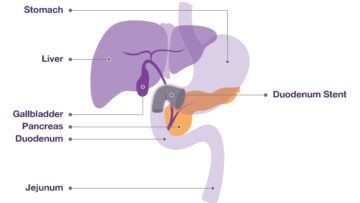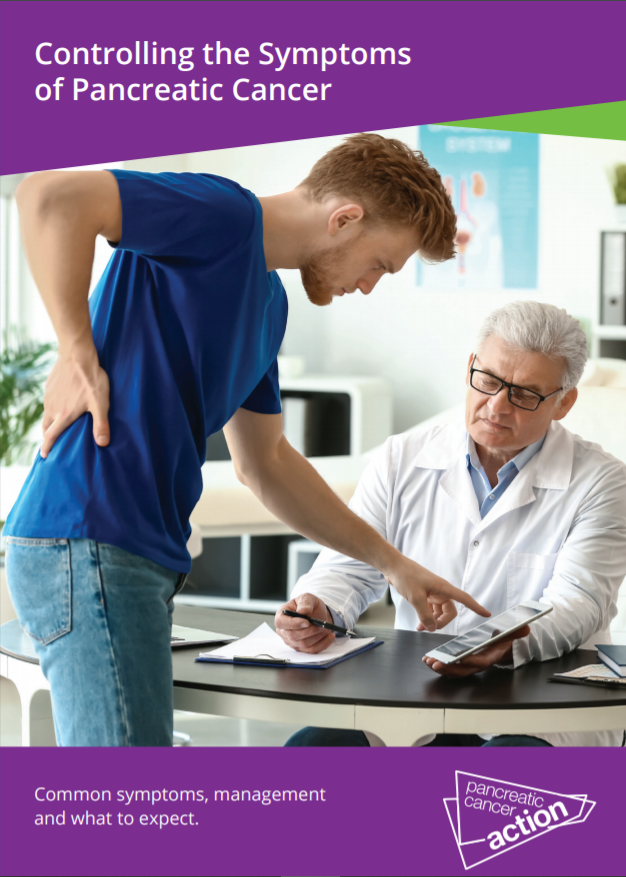Relieving jaundice with duodenal stent
 An alternative to a stomach bypass operation is the insertion of a stent (a small metallic mesh tube), which holds the sides of the duodenum open in the same way that a stent might relieve a blocked bile duct. The aim of putting in a stent is to allow food and other substances to pass through the stomach and reduce nausea and vomiting.
An alternative to a stomach bypass operation is the insertion of a stent (a small metallic mesh tube), which holds the sides of the duodenum open in the same way that a stent might relieve a blocked bile duct. The aim of putting in a stent is to allow food and other substances to pass through the stomach and reduce nausea and vomiting.
Where will I have a stent put in?
The procedure will be performed in a room in an X-ray department or endoscopy suite.
How long will it take to do?
The procedure will take approximately 30 minutes to perform.
Will this procedure work?
Stents can be placed successfully in about 94% of patients.
What happens?
You must not eat or drink anything for several hours before the stent is inserted (your medical team will tell you when to stop eating and drinking). If your vomiting has been severe, you may already have a nasogastric tube (a thin plastic tube which goes through you nose, down your throat and into stomach) in place, which can be used to drain your stomach.
You will be taken to the x-ray department or endoscopy suite, in your bed ready to have your intravenous sedation. When you are feeling sleepy, the doctor will pass an endoscope down your throat and put the stent through the blockage using other specialised equipment. When it is all over, you will remain in the department until you are more awake and then return to the ward.
When can I get home?
You will be able to go home when you feel ready. Usually, this is within a few days of the procedure.
Are there any complications?
Like any operation there is a slight risk of complications occuring during or after the procedure.
Complications linked with stent insertion include:
- Fluid getting into the lungs during the procedure.
- Bleeding.
- Puncture of the digestive tract.
- The stent moving.
- The stent causing an unwanted opening in the digestive tract.
Eating and drinking after the insertion of a stent
Because the stent doesn’t move and is about 3 to 4 inches long there is a tendency for solid food to get stuck. Consequently, rather than returning to a normal diet you will be encouraged to drink nourishing fluids and eat soft food to prevent the stent becoming blocked. Your dietitian can advise you on what to eat to avoid problems.
 The information provided in this site, or through links to other websites, is not a substitute for medical or professional care and should not be relied upon as such. Read our disclaimer.
The information provided in this site, or through links to other websites, is not a substitute for medical or professional care and should not be relied upon as such. Read our disclaimer.
Sources and references for this information product will be supplied on request. Please contact us quoting the Information Product number below:
| Information Product № |
PCA0013v1 |
Published |
15/10/2019 |
| Last Updated |
21/04/2022 |
Next Review Due |
21/04/2025 |
|---|

 An alternative to a stomach bypass operation is the insertion of a stent (a small metallic mesh tube), which holds the sides of the duodenum open in the same way that a stent might relieve a blocked bile duct. The aim of putting in a stent is to allow food and other substances to pass through the stomach and reduce nausea and vomiting.
An alternative to a stomach bypass operation is the insertion of a stent (a small metallic mesh tube), which holds the sides of the duodenum open in the same way that a stent might relieve a blocked bile duct. The aim of putting in a stent is to allow food and other substances to pass through the stomach and reduce nausea and vomiting. The information provided in this site, or through links to other websites, is not a substitute for medical or professional care and should not be relied upon as such.
The information provided in this site, or through links to other websites, is not a substitute for medical or professional care and should not be relied upon as such.